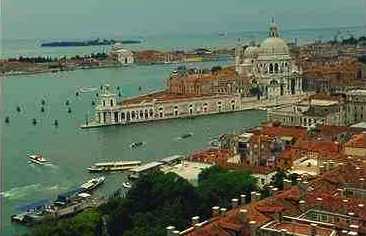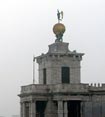|
Venice > Sightseeing > Dogana di Mare
Dogana di Mare

ABOVE: The Dogana di Mare is located at the Punta
della Dogana on the tip of
Dorsoduro, where the Grand Canal reaches its greatest width (231 feet or 70 meters) as it
merges with St. Mark's Basin.
By
Durant Imboden
Venice may be built on more than 100 islands and
millions of wooden pilings, but its real foundation has always been international trade
and tourism. For centuries, the Serene Republic of Venice was the meeting place of East
and West, with ships ferrying goods between Europe and ports from the Holy Land to the Far
East.
Arriving cargo ships were inspected by customs officials at the
Punta della Dogana,
or Customs Point. This wedge of land is at the entrance to the Grand Canal, across the
water and a few hundred yards to the west of St. Mark's Square. It offers one of Venice's
most beautiful views--from an ancient mariner's perspective, no less.
 The original 14th-Century customs tower was replaced by a handsome colonnaded building
named the Dogana di Mare, or Sea Customs Post, in the late 1600s. The original 14th-Century customs tower was replaced by a handsome colonnaded building
named the Dogana di Mare, or Sea Customs Post, in the late 1600s.
The current
building's tower is crowned by two Atlases (identical twins, presumably) holding up a
bronze globe. Atop the globe, another statue--Fortuna, or "Fortune"--acts as a
weathervane by holding a garment, or perhaps a ship's rudder, to the wind.
The interior of the Dogana di Mare is now home to contemporary artworks from the
Palazzo Grassi's
Pinault Collection.
In his Italian
Hours essay on Venice, Henry James describes the Dogana di Mare:
"The charming architectural promontory of the Dogana stretches out
the most graceful of arms, balancing in its hand the gilded globe on which revolves the
delightful satirical figure of a little weathercock of a woman. This Fortune, this
Navigation, or whatever she is called--she surely needs no name--catches the wind in the
bit of drapery of which she has divested her rotary bronze loveliness. On the other side
of the canal twinkles and glitters the long row of the happy palaces which are mainly
expensive hotels. There is a little of everything everywhere, in the bright Venetian air,
but to these houses belongs especially the appearance of sitting, across the water, at the
receipt of custom, of watching in their hypocritical loveliness for the stranger and
victim."
Reaching the Dogana di Mare
-
From the Piazzale Roma or the railway station, take the No. 1 vaporetto to the Salute
stop and walk along the promenade.
-
From the Piazza San Marco, take the No. 1 vaporetto to Salute or--better yet--ride
the inexpensive traghetto
or gondola ferry from the nearby Campo del Traghetto to the Dorsoduro side of
the canal. When
you step off the traghetto, walk inland to the first corner, turn left, and continue two
short blocks to the Salute church. (Another option is to walk from the Piazza
San Marco to the Accademia Bridge, cross
the bridge, then bear left and keep walking until you reach the Dogana di
Mare at the tip of Dorsoduro.)
About the author:
 Durant Imboden has
written about Venice, Italy since 1996.
He covered Venice and European travel at About.com for 4-1/2 years before launching
Europe for Visitors (including
Venice for Visitors) with Cheryl
Imboden in 2001. Durant Imboden has
written about Venice, Italy since 1996.
He covered Venice and European travel at About.com for 4-1/2 years before launching
Europe for Visitors (including
Venice for Visitors) with Cheryl
Imboden in 2001.
PC Magazine has called this "the premier visitors'
site for Venice, Italy." Over the years, it has helped more than 30 million
travelers. For more information, see About our site,
our Europe for Visitors
press clippings,
and
our reader testimonials.
| |
|